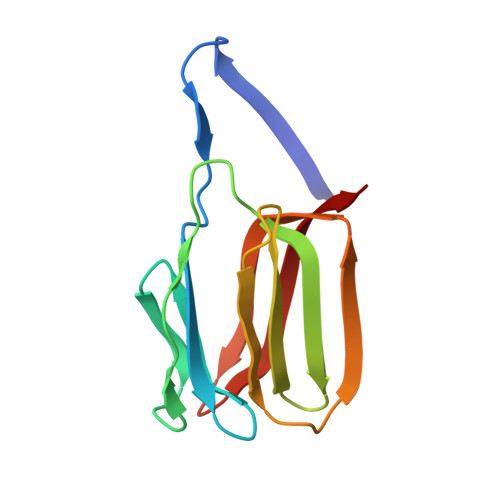Crystallographic, thermodynamic, and molecular modeling studies of the mode of binding of oligosaccharides to the potent antiviral protein griffithsin.
Ziolkowska, N.E., Shenoy, S.R., O'keefe, B.R., McMahon, J.B., Palmer, K.E., Dwek, R.A., Wormald, M.R., Wlodawer, A.(2007) Proteins 67: 661-670
- PubMed: 17340634
- DOI: https://doi.org/10.1002/prot.21336
- Primary Citation of Related Structures:
2HYQ, 2HYR - PubMed Abstract:
The mode of binding of oligosaccharides to griffithsin, an antiviral lectin from the red alga Griffithsia sp., was investigated by a combination of X-ray crystallography, isothermal titration calorimetry, and molecular modeling. The structures of complexes of griffithsin with 1-->6alpha-mannobiose and with maltose were solved and refined at the resolution of 2.0 and 1.5 A, respectively. The thermodynamic parameters of binding of 1-->6alpha-mannobiose, maltose, and mannose to griffithsin were determined. Binding profiles of 1-->6alpha-mannobiose and mannose were similar with Kd values of 83.3 microM and 102 microM, respectively. The binding of maltose to griffithsin was significantly weaker, with a fourfold lower affinity (Kd = 394 microM). In all cases the binding at 30 degrees C was entropically rather than enthalpically driven. On the basis of the experimental crystal structures, as well as on previously determined structures of complexes with monosaccharides, it was possible to create a model of a tridentate complex of griffithsin with Man9GlcNAc2, a high mannose oligosaccharide commonly found on the surface of viral glycoproteins. All shorter oligomannoses could be modeled only as bidentate or monodentate complexes with griffithsin. The ability to mediate tight multivalent and multisite interactions with high-mannose oligosaccharides helps to explain the potent antiviral activity of griffithsin.
Organizational Affiliation:
Protein Structure Section, Macromolecular Crystallography Laboratory, National Cancer Institute, NCI-Frederick, Frederick, Maryland 21702-1201, USA.

















